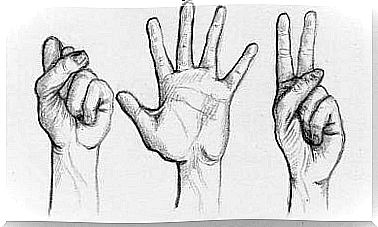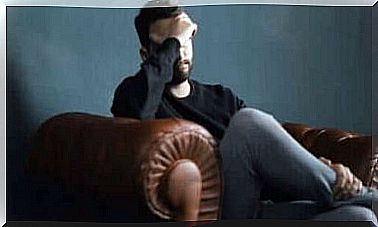Mowrer’s Two Factor Theory: This Is How Your Fears Work

Although Mowrer’s two-factor theory was first enunciated in 1939, it remains one of the most interesting models for two reasons. The first reason is that it allows us to understand the mechanisms of fear and how anxiety disorders and phobias occur. The second reason is that it gives us a valuable starting point for dealing with many of those manifestations where fear limits well-being.
Talking about anxiety is inevitably referring to fears and anxieties. No dimension is as complex as fear itself, and as the poet Horacio said , those who live in fear will never be free. Few arguments are as true as this one. On the other hand, nothing is as typical of human beings as having worries and fears.
It makes sense, after all, they are part of human nature and act as survival mechanisms. However , they can sometimes lead people to pathological states of helplessness. Panic disorders, obsessions and phobias orchestrate the daily lives of thousands of people and prevent them from living normal lives.
These are overwhelming, exhausting and difficult states to explain to someone who does not experience them. Understanding the most basic mechanics of fear can help you unmask your worst enemy. Let’s delve a little deeper into this subject.

What is Mowrer’s Two Factor Theory?
Mowrer’s two-factor theory was enunciated by Orval Hobart Mowrer in 1939. This American psychologist and professor of psychology at the University of Illinois is known for his research into behavioral therapy. One of his interests was to know how phobias originate and why they are so difficult to eliminate when they appear.
It is useless, for example, to explain to a person who is afraid of planes that the probability of being run over when crossing a traffic light is greater than in a plane crash. The mind clings to certain ideas and maintains them over time until they completely change our behavior. Dr. Mowrer was one of the pioneers in this matter. Also, thanks to him we know what are the mechanisms behind many anxiety processes.
According to Mowrer’s two-factor theory, fears, phobias and anxiety disorders arise from two stages.
- Imagine someone who needs to be in control of every aspect of their life, someone who is obsessive and very demanding. Suddenly, he gets on a plane for the first time and feels that he is not in control of this situation.
- He feels trapped and tied up high above the ground, which causes him to suffer a panic attack. As a result, he has not been able to board a plane since then.
- Not only that, but her fears increased. The idea of going on vacation or traveling for work terrifies him. Being forced to get on a plane again intensifies your anxiety even more.
In the example above, you can see two dimensions that define Mowrer’s two-factor theory. They are as follows:
Phase 1. Classic conditioning
Dr. Orval Hobart Mowrer focused his research on behaviorism. He established that the first process involving the emergence of phobias and many anxiety disorders is classical conditioning:
- An apparently neutral and innocuous stimulus (a plane, a spider, a work scene, a crowded supermarket, etc.) suddenly becomes a painful or traumatic stimulus.
- For example: “Since I had a bad experience with my co-workers, I have a hard time getting up, getting dressed and going to work. That place became a nightmare for me”.
- As you can see, at this stage, the person experienced something seemingly normal in an unpleasant way.
Phase 2. Instrumental conditioning
After suffering the impact of classical conditioning (a specific stimulus takes on a painful connotation), it would be enough to avoid this situation to return to normality. However, when it comes to phobias and anxiety, the brain works differently.
This is where the second phase comes in, that is, instrumental conditioning.
Let’s continue with the traumatic workplace example. If the person suffered some kind of harassment by their co-workers, it would be enough to leave that job for their suffering to end, right?
- This is not always the case. It could be something much more complex. For example, any work environment can remind you of that past experience.
- “When I remember everything that happened, I can’t go back to work. My mind relates any job to what I’ve been through in the past.”
- With this behavior, all she is doing is reinforcing the fear ; there is a stimulus that frightens her -> she avoids it -> she also avoids everything that reminds her of that original stimulus -> the fear becomes greater.
Therefore, one avoids not only the original aversive stimulus, but everything that comes close to it.

How can Mowrer’s two-factor theory help you?
As Giorgio Nardone points out , “Fear when looked at from the front turns into bravery and courage, while what is avoided always turns into panic”.
Mowrer’s two-factor theory shows the irrational basis of many fears and how they prevent an individual from living a normal life. There is nothing wrong with running away from what hurts, from what acts as a real threat. However, many of the fears and phobias are not logical or guarantee your survival. On the contrary, some fears do nothing but limit your life.
Exposure techniques are very well suited to dealing with these psychological realities. Putting oneself in front of the terrible phobic stimulus and rationalizing that fear is always a good step. Likewise, brief strategic therapy is also a good resource for unlocking everything that limits you and leaves you submerged in your fears.
Fighting your fears is your responsibility. Use the tools you have to do this.









